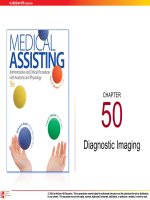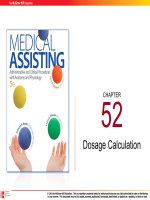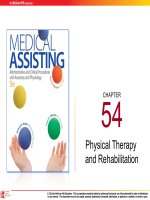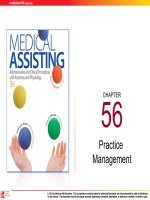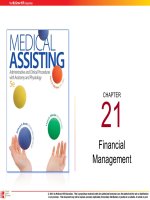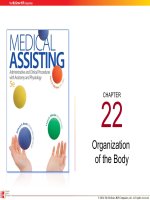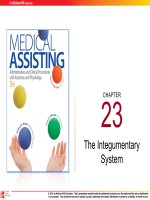Medical assisting Administrative and clinical procedures (5e) Chapter 43 Assisting with eye and ear care
Bạn đang xem bản rút gọn của tài liệu. Xem và tải ngay bản đầy đủ của tài liệu tại đây (916.83 KB, 44 trang )
CHAPTER
43
Assisting with Eye
and Ear Care
© 2014 by McGraw-Hill Education. This is proprietary material solely for authorized instructor use. Not authorized for sale or distribution
in any manner. This document may not be copied, scanned, duplicated, forwarded, distributed, or posted on a website, in whole or part.
43-2
Learning Outcomes (cont.)
43.1 Describe the medical assistant’s role in
eye exams and procedures performed in a
medical office.
43.2 Discuss various eye disorders
encountered
in a medical office.
43.3 Identify ophthalmic exams performed in
the physician’s office.
43.4 Summarize ophthalmologic procedures
and treatments.
© 2014 by McGraw-Hill Education. This is proprietary material solely for authorized instructor use. Not authorized for sale or distribution
in any manner. This document may not be copied, scanned, duplicated, forwarded, distributed, or posted on a website, in whole or part.
43-3
Learning Outcomes (cont.)
43.5 Describe the medical assistant’s role in
otology.
43.6 Describe disorders of the ear
encountered in the medical office.
43.7 Recall various hearing and other
diagnostic
ear tests.
43.8 Summarize ear procedures and
treatments.
© 2014 by McGraw-Hill Education. This is proprietary material solely for authorized instructor use. Not authorized for sale or distribution
in any manner. This document may not be copied, scanned, duplicated, forwarded, distributed, or posted on a website, in whole or part.
43-4
Introduction
• Think how often you use your eyes and ears
• Good eye and ear care is critical
• Ophthalmology and otology
– Disorders
– Exams and procedures
© 2014 by McGraw-Hill Education. This is proprietary material solely for authorized instructor use. Not authorized for sale or distribution
in any manner. This document may not be copied, scanned, duplicated, forwarded, distributed, or posted on a website, in whole or part.
43-5
Ophthalmology
• Specialty of the anatomy, function and
diseases of the eye
• Ophthalmologists
• Medical assistant
– Visual acuity
– Color vision
– Intraocular pressure
© 2014 by McGraw-Hill Education. This is proprietary material solely for authorized instructor use. Not authorized for sale or distribution
in any manner. This document may not be copied, scanned, duplicated, forwarded, distributed, or posted on a website, in whole or part.
43-6
Eye Diseases and Disorders
• Disorders of external eye structures
– Blepharitis ~ chronic inflammation of the eyelid’s
edges
– Ptosis ~ droopy upper eyelid
– Sty ~ eyelash follicle infection
© 2014 by McGraw-Hill Education. This is proprietary material solely for authorized instructor use. Not authorized for sale or distribution
in any manner. This document may not be copied, scanned, duplicated, forwarded, distributed, or posted on a website, in whole or part.
43-7
Eye Diseases and Disorders (cont.)
• Disorders of structures of the front of the eye
– Conjunctivitis
• Allergic
• Infectious
– Corneal ulcers and abrasions
© 2014 by McGraw-Hill Education. This is proprietary material solely for authorized instructor use. Not authorized for sale or distribution
in any manner. This document may not be copied, scanned, duplicated, forwarded, distributed, or posted on a website, in whole or part.
43-8
Eye Diseases and Disorders (cont.)
• Disorders involving internal eye structures
– Cataracts ~ cloudy or
opaque lens
– Glaucoma ~ increased fluid
pressure
– Iritis ~ inflammation of the iris
and sometimes the ciliary body
© 2014 by McGraw-Hill Education. This is proprietary material solely for authorized instructor use. Not authorized for sale or distribution
in any manner. This document may not be copied, scanned, duplicated, forwarded, distributed, or posted on a website, in whole or part.
43-9
Eye Diseases and Disorders (cont.)
• Disorders of the Retina
– Retinal detachment ~ retina separate from the middle,
vascular layer of the eye
– Diabetic retinopathy ~ damage to small blood vessels
supplying the retina
– Macular degeneration ~ dark spot in the center of the
field of vision
© 2014 by McGraw-Hill Education. This is proprietary material solely for authorized instructor use. Not authorized for sale or distribution
in any manner. This document may not be copied, scanned, duplicated, forwarded, distributed, or posted on a website, in whole or part.
43-10
Eye Diseases and Disorders (cont.)
• Disorders involving eye movement
– Strabismus
• Deviation of one eye
• Children – misaligned or
unbalanced muscles
• Adults – nerves and/or muscles
– Amblyopia ~ “Lazy” eye
© 2014 by McGraw-Hill Education. This is proprietary material solely for authorized instructor use. Not authorized for sale or distribution
in any manner. This document may not be copied, scanned, duplicated, forwarded, distributed, or posted on a website, in whole or part.
43-11
Eye Diseases and Disorders (cont.)
• Refractive disorders
– Myopia
– Hyperopia
– Presbyopia
– Astigmatism
© 2014 by McGraw-Hill Education. This is proprietary material solely for authorized instructor use. Not authorized for sale or distribution
in any manner. This document may not be copied, scanned, duplicated, forwarded, distributed, or posted on a website, in whole or part.
43-12
Apply Your Knowledge
True or False
ANSWER:
T An ophthalmologist specializes in treating eyes and
related tissues. A sty
F Blepharitis is the result of an eyelash follicle infection.
F Viral or bacterial conjunctivitis is not easily spread.
T In glaucoma, fluid pressure builds up in the eye.
F There is a loss of the vision in the center of the eye
with
macular degeneration
retinal detachment.
T
Presbyopia is related to aging.
T
Visual defects are the most common eye disorders
treated by ophthalmologists.
© 2014 by McGraw-Hill Education. This is proprietary material solely for authorized instructor use. Not authorized for sale or distribution
in any manner. This document may not be copied, scanned, duplicated, forwarded, distributed, or posted on a website, in whole or part.
43-13
Ophthalmic Exams
• Ophthalmoscope
• Tests
– Visual fields
– Convergence of the
eyes
– Glaucoma – tonometer
© 2014 by McGraw-Hill Education. This is proprietary material solely for authorized instructor use. Not authorized for sale or distribution
in any manner. This document may not be copied, scanned, duplicated, forwarded, distributed, or posted on a website, in whole or part.
43-14
Ophthalmology Exams
• Slit lamp
• Refraction exam
© 2014 by McGraw-Hill Education. This is proprietary material solely for authorized instructor use. Not authorized for sale or distribution
in any manner. This document may not be copied, scanned, duplicated, forwarded, distributed, or posted on a website, in whole or part.
43-15
Types of Vision Screening Tests
• Includes tests for
– The ability to see clearly
– The ability to distinguish shades
of grey and colors
• Screening
– Snellen chart
– Jaegar chart
– Ishihara book
© 2014 by McGraw-Hill Education. This is proprietary material solely for authorized instructor use. Not authorized for sale or distribution
in any manner. This document may not be copied, scanned, duplicated, forwarded, distributed, or posted on a website, in whole or part.
43-16
Types of Vision Screening Tests (cont.)
• Near Vision
– Hyperopia
– Presbyopia
• Contrast
Sensitivity
– Shades of gray
– Cataracts / retinal
problems
• Color vision
(Reprinted with permission of Richmond
Products, Inc.)
– Color-blindness
– Retina / optic nerve
problems
© 2014 by McGraw-Hill Education. This is proprietary material solely for authorized instructor use. Not authorized for sale or distribution
in any manner. This document may not be copied, scanned, duplicated, forwarded, distributed, or posted on a website, in whole or part.
43-17
Apply Your Knowledge
Match the following: ANSWER:
A. Refraction exam
B. Otoscope
measures
intraocular
pressure
E
C. Distance visual
G used to examine the anterior
acuity
eye
A
D. Color-blindness
verifies the need for corrective E. Tonometer
lenses
C
F. Near vision
Snellen chart
G. Slit lamp
F
D Jaegar chart
B used to view the inner eye
Ishihara book
Correct
© 2014 by McGraw-Hill Education. This is proprietary material solely for authorized instructor use. Not authorized for sale or distribution
in any manner. This document may not be copied, scanned, duplicated, forwarded, distributed, or posted on a website, in whole or part.
43-18
Ophthalmologic Procedures and
Treatments
• Minor injury or infection – lasting
consequences
• Medical assistant
– Proper technique
– Patient education
• Routine care
• Warning signs
• Use of protective
equipment
© 2014 by McGraw-Hill Education. This is proprietary material solely for authorized instructor use. Not authorized for sale or distribution
in any manner. This document may not be copied, scanned, duplicated, forwarded, distributed, or posted on a website, in whole or part.
43-19
Administering Medications to the Eye
• Purposes
–
–
–
–
Assist patients in eye tests
Reduces pressure in the eye
Relieves eye pain
Treats infections
• Medical assistant
– Dispense eye medication
– Patient instructions
© 2014 by McGraw-Hill Education. This is proprietary material solely for authorized instructor use. Not authorized for sale or distribution
in any manner. This document may not be copied, scanned, duplicated, forwarded, distributed, or posted on a website, in whole or part.
43-20
Administering Medications to the
Eye (cont.)
• Eye irrigation
– Remove foreign materials
– Relieve discomfort
• Use sterile solution
© 2014 by McGraw-Hill Education. This is proprietary material solely for authorized instructor use. Not authorized for sale or distribution
in any manner. This document may not be copied, scanned, duplicated, forwarded, distributed, or posted on a website, in whole or part.
43-21
Apply Your Knowledge
When administering eye medications, you
should avoid touching the tip of the dropper or
tube to the eye. Why?
ANSWER: Touching the tip of the dropper or
ointment tube can injure the eye, cause
infection, and contaminate the medication.
Excellent!
© 2014 by McGraw-Hill Education. This is proprietary material solely for authorized instructor use. Not authorized for sale or distribution
in any manner. This document may not be copied, scanned, duplicated, forwarded, distributed, or posted on a website, in whole or part.
43-22
Otology
• Otologist – treats diseases and disorders of
the ears
• Medical assistant
– Auditory screening
– Administer ear medications
– Perform ear irrigations
– Assist with diagnostic tests
© 2014 by McGraw-Hill Education. This is proprietary material solely for authorized instructor use. Not authorized for sale or distribution
in any manner. This document may not be copied, scanned, duplicated, forwarded, distributed, or posted on a website, in whole or part.
43-23
Apply Your Knowledge
What are the functions of a medical assistant
related to otology?
ANSWER: The medical assistant may
Perform auditory screening
Administer ear medications
Perform ear irrigations
Assist with diagnostic tests
HEAR! HEAR!
© 2014 by McGraw-Hill Education. This is proprietary material solely for authorized instructor use. Not authorized for sale or distribution
in any manner. This document may not be copied, scanned, duplicated, forwarded, distributed, or posted on a website, in whole or part.
43-24
Ear Diseases and Disorders
Common Disorders of the Outer Ear
• Cerumen impaction
– Eardrops to soften
wax
– Irrigation to remove it
• Otitis externa
– Swimmer’s ear
– Medicated drops
• Pruritus
– Less wax with aging
– Mineral oil drops
© 2014 by McGraw-Hill Education. This is proprietary material solely for authorized instructor use. Not authorized for sale or distribution
in any manner. This document may not be copied, scanned, duplicated, forwarded, distributed, or posted on a website, in whole or part.
43-25
Common Disorders of the Middle Ear
• Otitis Media
– Fluid buildup
– Ear infection
• Mastoiditis
• Otosclerosis
– Abnormal bone
tissue growth
– Hearing loss and
tinnitus
• Ruptured ear
drum
© 2014 by McGraw-Hill Education. This is proprietary material solely for authorized instructor use. Not authorized for sale or distribution
in any manner. This document may not be copied, scanned, duplicated, forwarded, distributed, or posted on a website, in whole or part.
